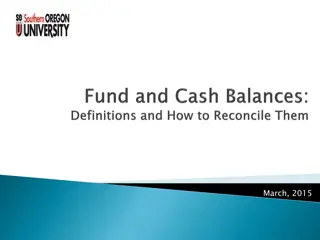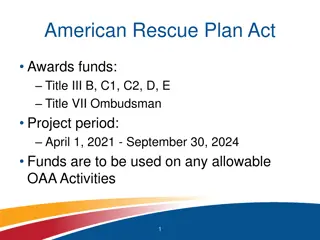Maximizing Title IV Part A Funds for Well-Rounded Education
The Title IV Part A program focuses on providing well-rounded education opportunities to students. Districts receiving over $30,000 must conduct a needs assessment and allocate at least 20% of funds for well-rounded activities. Funds can be maximized by collaborating with outside organizations such as non-profits, universities, and museums. However, it is crucial to supplement and not supplant state or local funds. Allowable expenses include salaries, curriculum, professional development, instructional materials, and field trips that are educational in nature. Proper documentation and adherence to guidelines are essential for maximizing the impact of Title IV Part A funds.
Download Presentation

Please find below an Image/Link to download the presentation.
The content on the website is provided AS IS for your information and personal use only. It may not be sold, licensed, or shared on other websites without obtaining consent from the author.If you encounter any issues during the download, it is possible that the publisher has removed the file from their server.
You are allowed to download the files provided on this website for personal or commercial use, subject to the condition that they are used lawfully. All files are the property of their respective owners.
The content on the website is provided AS IS for your information and personal use only. It may not be sold, licensed, or shared on other websites without obtaining consent from the author.
E N D
Presentation Transcript
Title IV, Part A Well-Rounded Education Division of Student Success Office of Continuous Improvement and Support 2
Distribution of Funds Districts that receive $30,000 or more must conduct a Comprehensive Needs Assessment and select activities based on the results of that assessment. With an allocation over $30,000, districts must spend at least 20% of their allocation to support well-rounded educational opportunities 3
Maximizing Funds LEAs can partner with non-profits, institutions of higher education, museums, and community organizations. Title IV, Part A funds can be blended with other funds to fully fund and support an activity. 4
District Examples of Partnering with Outside Organizations AmeriCorps Teach for America Local colleges and universities Technical schools Local Co-ops 5
Supplement/Not Supplant Section 4110 requires that SSAE program funds be used to supplement, and not supplant, non-Federal funds that would otherwise be used for activities authorized under the SSAE program. This means that an LEA may not use SSAE program funds to carry out activities that would otherwise be paid for with State or local funds. In determining whether a particular use of funds would violate the non- supplanting requirement, LEAs should consider matters such as whether the cost involved is currently paid for using State or local funds or whether the cost involved is for an activity that is required by State or local law. In no event may LEAs decrease the amount of State or local funds used to pay the cost of an activity simply because of the availability of the SSAE program funds. 6
Allowable Expenses Salaries Curriculum Professional development (travel, registration, subs, meals, etc.) Instructional materials Food* (see following slides) Field trips* (see following slides) 7
Field Trips Field trips MUST be educational in nature. The following are NOT allowable: Trips for social, entertainment or recreational purposes (i.e. amusement parks, concerts, live performances) Trips that are not reasonable in cost or necessary to accomplish the objectives of the grant program Trips not part of a teacher s lesson plan or that do not meet the instructional objectives of the grant Trips that supplant and do not supplement local or state expenditures or activities Field trips that are not properly documented 8
Food and Beverage Costs Costs are authorized in support of approved activities in the grant application to include: Light snacks may be purchased to support parent involvement activities to encourage participation Nutritional snacks for students for extended day or summer programs Food necessary to conduct nutrition education programs for students. Expenditures must be reasonable in cost, necessary to accomplish program objectives, and an integral part of the instructional program. 9
Food and Beverage Costs (cont.) The following are NOT allowable: Food costs that are not necessary to accomplish the objectives of the grant program Refreshments or meals at awards banquets or functions Full meals for parents or students are not allowable for these purposes under any circumstances. 10
Use of Funds around the State Music curriculum and materials Foreign language program Certified salaries for intervention/enrichment services Arts programs and materials Field trips for the arts and STEM Teach for America Family literacy and community literacy programs STEM programs and materials Instructional support and tutoring for EL students Pre-K reading and readiness program Certified or classified salaries to support activities under the grant Gifted/Talented Enrichment Activities 11
Use of Funds around the State (2) Summer and after school programs STEM and the Arts Teleconferences Expanding dual credit offerings within the school PD for STEM, the arts, Accelerated Learning, Cooperative Learning, Culturally Responsive teaching, and career tech education Instructional coaches College and Career Coach/Counselor Transition supports for alternative school students Assemblies for the Arts Social and Emotional Learning Curriculum PBIS coach Guidance counselor 12
Purchasing Technology Technology can be purchased to support activities under Well-Rounded Education if it is integral to the running of the program. If the program cannot be carried out without purchasing technology, it is allowed. If technology is being purchased to enrich the learning experience, or is supplemental, then it is not allowable. 13
Purchasing Technology Example A district s scores are low in science and math and their student s exposure to technology and tech-related jobs also needs to be increased. The district determines implementing a new STEM curriculum will help increase the scores. One component of the new curriculum is a Coding Course. The purchase of Coding Software is necessary to implement the program. 14
Cross Cutting Activities Activities that could be categorized under more than one content area for Title IV, Part A is considered cross-cutting. Districts that receive over $30,000 can choose cross-cutting activities that align with their Needs Assessment and spend the majority of funds on those activities. 15
Approved Cross-Cutting Activities College and Career Counselor/Coach PBIS Coach Social Emotional Learning Curriculum Health and P.E. curriculum, materials, or salaried position Mentoring and School Counseling 16
Cross-Cutting Activity Examples A district receives $35,000 in Title IV, Part A funds and their needs assessment identifies the need for an additional counselor at their high school The majority of funds can be spend under Well-Rounded Education and Safe and Healthy Students to partially fund the new position. ($34,900) A portion of funds needs to support Effective Use of Technology category. The portion just needs to be reasonable to support an activity in this category and can be blended with another funding source. Ex. The district is providing training for teachers to become proficient in using Google Classroom and is using Title II funds to cover the majority of the cost of the training. Title IV, Part A funds will cover the cost of a sub for one day. 17
Resources at KDE General Title IV, Part A grant questions: Lalah Brewer (502) 564-4772 ext. 4028 lalah.brewer@education.ky.gov Budget questions: Thelma Hawkins (502) 564-1979 ext. 4361 thelma.hawkins@education.ky.gov 18























